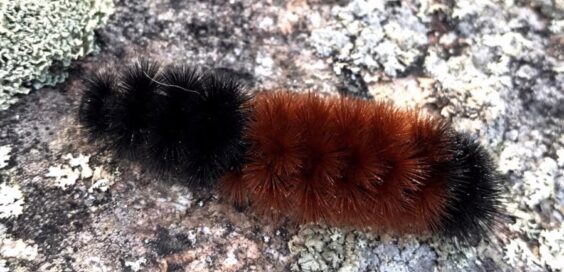
Creature Feature – Marching Towards Winter
Posted by Dustin Horton // October 9, 2023 // Articles, Creature Feature
As fall creeps closer towards winter, certain types of caterpillars march along in search of a good place to hibernate and can be found trundling doggedly along on warmer, sunny days. These special caterpillars can survive winter’s cold because they contain cryptoprotectant (a natural antifreeze) that prevents their cells from freezing solid.
The Woolly Bear is likely our most recognizable caterpillar. Many of us are familiar with the whimsical folklore that claims it can predict winter’s severity based on its rust and black colours – specifically, the more body area covered in black fuzz, the worse winter will be. As an adult, the Woolly Bear is far less recognizable as an Isabella Tiger Moth.
A lesser known cold-hardy caterpillar belongs to the Giant Leopard Moth. This big caterpillar is all black except for narrow red bands. It’s covered in dense, prickly bristles that don’t sting, but can discourage some predators. Because the red bands aren’t always noticeable, people often mistake the Giant Leopard Moth caterpillar for an all-black Woolly Bear (a rare thing); but while these two caterpillars share some characteristics and behaviors, they’re separate species. The Giant Leopard Moth caterpillar will eventually turn into a huge white moth with striking black spots on wings.
Both of these caterpillars are attracted to hibernating places among leaf litter, logs, and rocks and will appreciate an area in your yard left untidy. When we “leave the leaves,” we are helping these and countless other creatures survive the challenges of winter.
Article & photo by Margie Manthey













